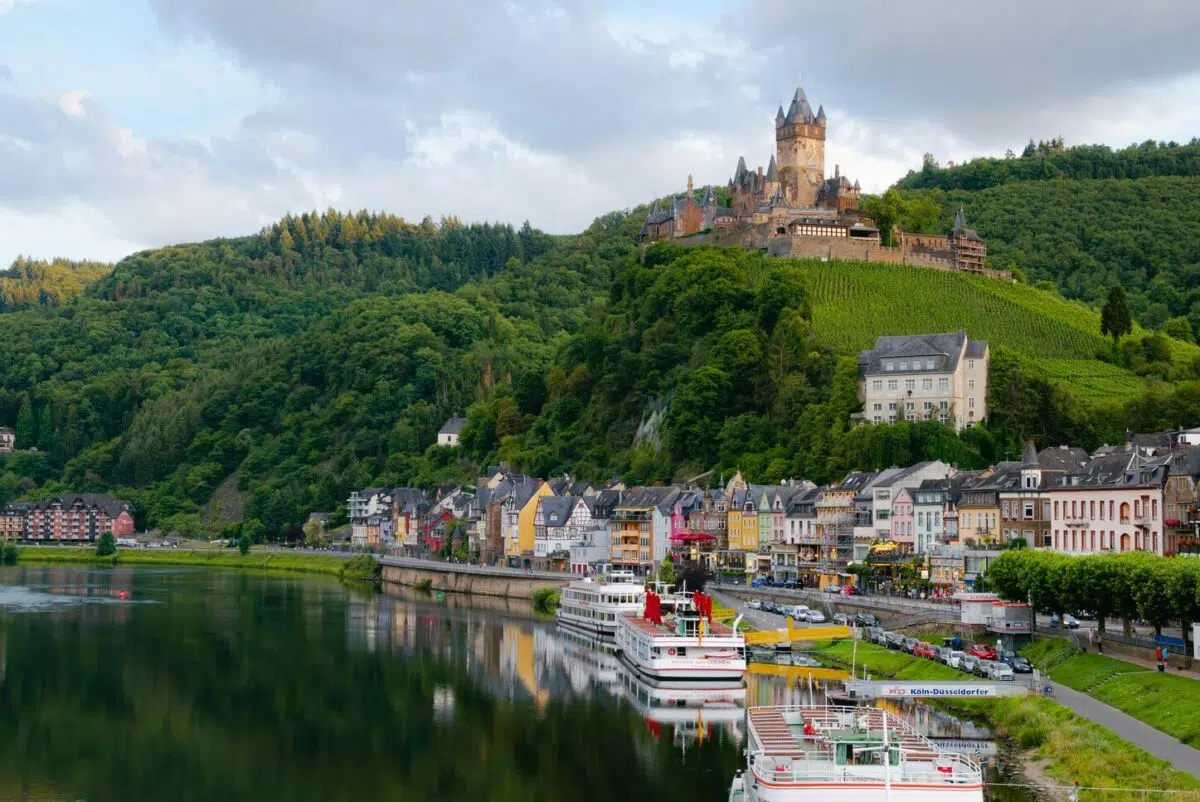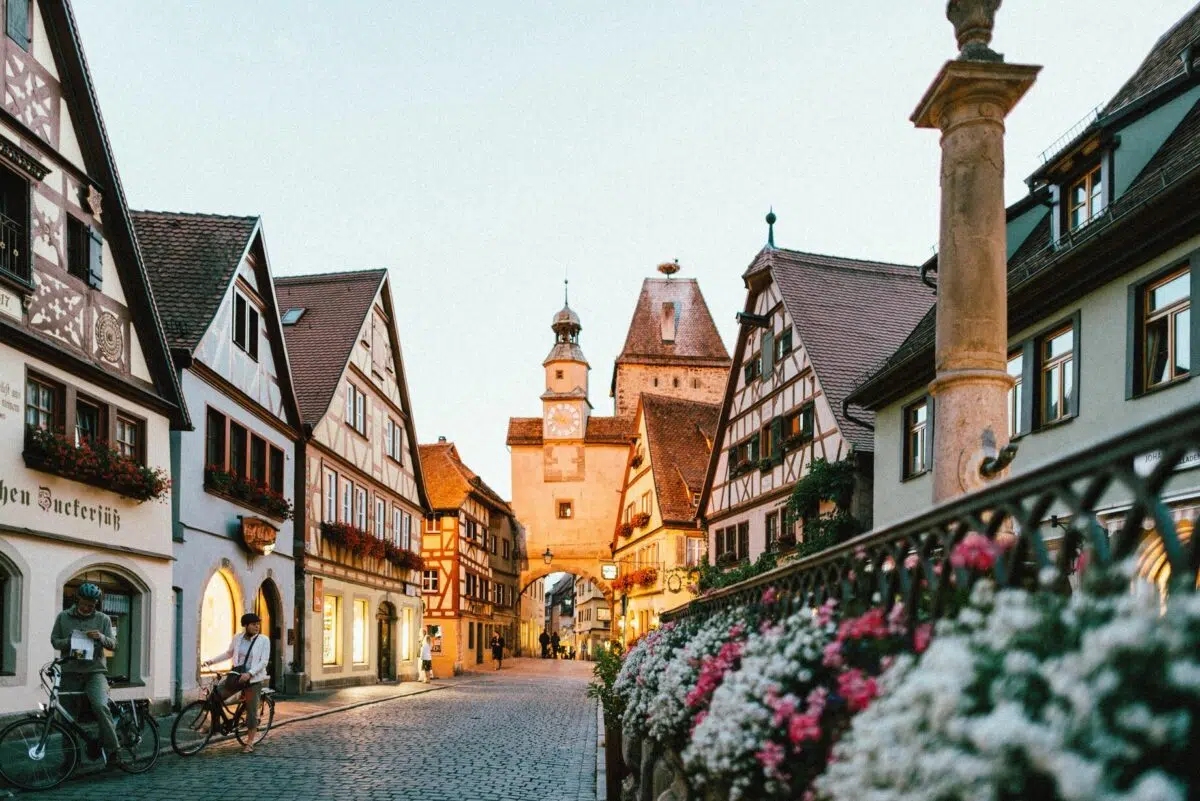
Traveling to Europe during the winter can be perfect for several reasons, such as getting cozy and witnessing the spectacular Northern Lights or even taking part in winter sports such as skiing. If the cold is not your thing, Europe can also be the best winter destination to escape from the cold. Head towards southern Spain for some winter sun, giving you the best of both worlds.
Many popular tourist destinations are also less crowded in the winter, which means shorter lines, easier access to attractions, and it is not so hot!
Traveling in the off-peak season of winter also often means lower prices for accommodations, flights, and attractions. You can stretch your budget further and enjoy more for less. Europe comes alive during the winter with enchanting Christmas markets, festive decorations, and holiday events. Cities like Vienna, Prague, and Strasbourg are known for their magical Christmas markets that can’t be seen any other time of the year.
Best European Cities To Visit in Winter

The best European cities to visit in winter largely depend on your personal preferences and interests. Europe can be visited by plane, train, or even cruise ship, making it easily accessible. You can also explore hidden parts of canals or choose to river cruise in Europe.
Are you looking for snowball fights and magic? Or sunshine and fiestas? We have rounded up our top six winter city breaks in European cities that are popular for their charm and cultural attractions, whether you are following the snow or sun.
Whether you are seeking the winter sun in the Algarve or magical snowscapes and Santa Claus, we have you covered with these great ideas for the best European cities to visit in winter.
Vienna Austria
Vienna is a stunning city in which to take a magical winter break as it exudes a fairytale-like atmosphere during the winter months. You can explore its stunning palaces, visit enchanting Christmas markets, and enjoy classical music concerts.
Winters in Vienna are cold, and there is a good chance of Snow. December can be slightly warmer, with an average of over 32 degrees Fahrenheit. January and February are the coldest months of the year, with temperatures way below freezing, so you must wrap up warm.
Explore the Cultural and Historical Landmarks
Vienna is a city steeped in history, and its historic landmarks are a testament to its rich past. Begin your exploration at the Hofburg Palace, the former imperial palace of the Habsburgs, which now houses several museums, including the Imperial Apartments and the Sisi Museum. Nearby, you’ll find the Spanish Riding School, where you can witness the famous Lipizzaner horses perform classical dressage.
The historic center of Vienna, a UNESCO World Heritage site, is a treasure trove of architecture and culture. St. Stephen’s Cathedral, with its stunning Gothic design, is a must-visit, and you can climb its tower for panoramic city views. Don’t forget to explore the Belvedere Palace, a masterpiece of Baroque architecture, which now houses an impressive art collection featuring works by Gustav Klimt, Egon Schiele, and more.
Indulge in Classical Music and the Arts
Vienna is often referred to as the “City of Music” because of its deep-rooted musical heritage. Attend a concert or opera performance at the renowned Vienna State Opera, or visit the House of Music to explore the city’s musical history and interactive exhibits. The Mozarthaus Vienna, where Wolfgang Amadeus Mozart lived, offers insight into the composer’s life. Additionally, Vienna’s coffeehouse culture is integral to its artistic atmosphere. Spend time at a traditional Viennese coffeehouse, like Café Central or Café Sacher, where intellectuals, artists, and musicians have gathered for centuries.
Visit Parks and Find Culinary Delights
Vienna is also known for its green spaces. The Schönbrunn Palace and Gardens, the former summer residence of the Habsburgs, is a sprawling complex with a palace, elaborate gardens, and the world’s oldest zoo, the Tiergarten Schönbrunn. The Prater Park is another famous spot, known for its iconic Giant Ferris Wheel and an amusement park. For a more tranquil experience, visit the Vienna Woods (Wienerwald) for hiking and nature walks. Vienna’s culinary scene is a treat for the taste buds.
Try traditional Viennese dishes like Wiener Schnitzel and Sachertorte at historic restaurants. The Naschmarkt, a bustling food market, is a great place to sample international and local cuisines.
Munich, Germany
Munich, the capital of Bavaria in Germany, is famous for its Christmas markets, where you can enjoy warm mulled wine, gingerbread cookies, and festive decorations. The city also offers beautiful winter parks and museums.
Explore Cultural and Historical Landmarks
Munich is steeped in history and boasts a variety of cultural landmarks, such as the famous Glockenspiel in the historic Marienplatz. In this square, you can witness the chimes from the New Town Hall and find numerous museums. The Residenz, once the royal palace of the Bavarian monarchs, is a vast complex showcasing opulent rooms and the Bavarian Crown Jewels.
Don’t miss a visit to the world-renowned Munich Pinakotheken, a group of art museums featuring works from various periods. The Deutsches Museum is a fascinating science and technology museum, and the Documentation Center for the History of National Socialism offers insight into the city’s wartime past. Discover the iconic Frauenkirche, a stunning Gothic cathedral that is one of Munich’s defining landmarks. You can also venture out to the Dachau Concentration Camp Memorial Site, a somber yet important reminder of the Holocaust.
Experience Culinary Delights and Beer Culture
Munich is a food lover’s paradise. Savour traditional Bavarian dishes such as pretzels, sausages, sauerkraut, and schnitzel in one of the city’s charming beer gardens or local restaurants. Don’t forget to try Weißwurst, a traditional Bavarian white sausage typically enjoyed with sweet mustard. Munich is renowned for its beer culture, and you can experience this firsthand at one of the city’s historic beer halls, like the Hofbräuhaus, or during Oktoberfest, the world’s largest beer festival. Try various Munich beers, including the classic Hefeweizen, a wheat beer.
Find Parks, Green Spaces, and Outdoor Activities
Munich offers a plethora of outdoor activities and green spaces. The Englischer (English Garden) is one of the largest city parks globally, with serene landscapes, walking paths, and the Eisbach River, known for its standing wave, popular among surfers. The Nymphenburg Palace Gardens are perfect for leisurely strolls and picnics. Visit the serene Lake Starnberg just outside Munich for swimming, sailing, and relaxation. The city is surrounded by the beautiful Bavarian Alps, offering opportunities for hiking, skiing, and other outdoor adventures.
Budapest, Hungary
Budapest is the Capital of Hungary and is known for its stunning architecture as well as its thermal baths. The city has one of Europe’s most highly-rated Christmas markets, which just adds to the winter charm.
Find History and Architecture
Budapest is a treasure trove of historical and architectural wonders. Take a visit to Buda Castle, perched on Castle Hill, which offers panoramic views of the city. Explore the castle complex, including the Budapest History Museum and the Hungarian National Gallery. Nearby, you’ll find Matthias Church, an iconic Gothic church with colorful roof tiles. You can also stroll along the Fisherman’s Bastion, a terrace with fairytale-like turrets and beautiful views.
Cross the iconic Chain Bridge to Pest and visit the Hungarian Parliament Building, an impressive Neo-Gothic structure along the Danube River.
Along here, you will find the Shoes on the Danube, which are a memorial and a monument to the Hungarian Jews who, in the winter of 1944-1945, were shot on the banks of the Danube River by the members of the Arrow Cross Party. Take a walk along Andrássy Avenue, a UNESCO World Heritage site lined with grand 19th-century buildings leading to Heroes’ Square. Explore the Jewish Quarter, home to Europe’s largest synagogue and the poignant Holocaust Memorial. All of these spots are ideal places to visit if you’re on a Viking river cruise on the Danube and stopping in Budapest.
Experience the Cultural and Arts Scene
Budapest has a vibrant cultural and arts scene. Visit the Hungarian State Opera House for a world-class opera or ballet performance. The Museum of Fine Arts and the Hungarian National Museum house remarkable art and history collections.
The House of Terror Museum offers a poignant look at the city’s 20th-century history. Enjoy a classical music concert at St. Stephen’s Basilica or one of the many charming chamber music venues. Budapest’s pubs built from ruins, like Szimpla Kert, are unique nightlife experiences set in abandoned buildings filled with eclectic decor and live music.
Explore Culinary Delights and Outdoor Activities
Sample traditional Hungarian dishes such as goulash, chimney cake (kürtőskalács), and Hungarian wine in a local restaurant or market. Try a traditional Hungarian pastry, rétes (strudel), with coffee in one of the city’s charming coffeehouses or street stalls. Take a leisurely cruise on the Danube River in the evening to enjoy breathtaking views of illuminated landmarks. For outdoor enthusiasts, Margaret Island is a peaceful green oasis in the heart of the city, ideal for a bike ride or a relaxing picnic. Explore City Park, which houses Vajdahunyad Castle, the Budapest Zoo, and the famous Széchenyi Thermal Bath. The Széchenyi Thermal Bath is one of the city’s famous bathhouses, and Gellért Baths is known for its Art Nouveau design.
Other European cities to consider in the winter include:
- Prague, Czech Republic
- Salzburg, Austria
- Stockholm, Sweden
- Reykjavik, Iceland
- Bruges, Belgium
- Tallinn, Estonia
- Zurich, Switzerland
- Amsterdam
- Venice, Italy
- Paris, France
- Copenhagen, Denmark
Best European Cities To Visit in Winter for Summer Sun
Escape to the warmer parts of Europe with our list of where to visit for summer sun during the winter.
Malaga, Spain
Located on the Costa del Sol, the picturesque city of Malaga enjoys a mild Mediterranean climate. Nestled on the southern coast of Spain in the Andalusia region, you can choose to go skiing in the mountains of Nerja and relax on the beach in the afternoon. Its rich history and culture make it a great winter break and an ideal destination for sunshine and pleasant temperatures even in winter.
Hike up to the Alcazaba
In the heart of the city, the Alcazaba you will find the splendid Moorish fortress, standing as a testament to Malaga’s historical significance. This architectural marvel features well-preserved walls, enchanting gardens, and intricate details that provide a glimpse into the city’s past. Nearby, the Gibralfaro Castle offers breathtaking panoramic views of Malaga’s Stunning Spanish Port, and you can choose to either hike up to the castle or take a bus.
Catch the Sun in Malaga’s Old Town and Museums
Wandering through Malaga’s historic center is a must. The labyrinthine streets, quaint squares, and historic buildings, such as the Plaza de la Constitución, immerse you in the city’s charm.
If you are an art enthusiast, you should not miss the Picasso Museum, as Malaga is the birthplace of the renowned artist. The museum houses an extensive collection of his works, shedding light on his artistic evolution. Malaga Cathedral, also known as “La Manquita,” is another architectural gem in the old town and is a Renaissance masterpiece boasting intricate designs and a rich history.
Find Shopping and Dinner in Malaga
For those seeking retail therapy and a taste of local life, a stroll along Calle Larios is a must. This bustling street is a shopping hub with a vibrant atmosphere. The Atarazanas Market is another great stop on your culinary journey through Malaga. You can savor fresh local produce, seafood, and traditional Spanish Tapas here.
As for relaxation and leisure, head to Malagueta Beach for swimming, sunbathing, and enjoying beachside dining restaurants. Paseo del Parque is a tranquil botanical garden nestled in the heart of the city, providing a peaceful respite from the urban buzz.
Alicante, Spain
Alicante, on the Costa Blanca, boasts a warm Mediterranean climate on the coast of the Mediterranean Valencian Community. Its microclimate makes it a great destination for those seeking sunny days during the winter. You can explore its historic castle and relax on the beaches.
Head to the Beach
Alicante is renowned for its stunning beaches; one of the most popular is Playa del Postiguet. Head from the cobbled streets down to the golden sands and clear waters of the beach located right in the heart of the city. San Juan Beach, a few miles north, offers a more extensive stretch of coastline and is perfect for water sports and relaxation. You can also explore nearby coves like Cala del Morro Blanc and Cala del Cantalar for a quieter and more intimate beach experience.
Don’t forget to take a leisurely walk along the picturesque Explanada de España, a palm-lined promenade along the waterfront.
Visit the Historical and Cultural Sites
Alicante’s historic center is a treasure trove of history. The Santa Bárbara Castle perched atop Mount Benacantil is a must-visit But a bit of a climb. You can reach it by taking a scenic hike, a lift, or even an elevator carved into the mountain. The castle offers spectacular panoramic views of the city and the sea.
The Explanada de España, mentioned earlier for its beautiful promenade, is also home to some of Alicante’s best cafes and restaurants. Explore the Santa Maria Basilica and the Santa Iglesia Concatedral de San Nicolás de Bari de Alicante for a glimpse into the city’s religious heritage.
Indulge in Gastronomy and Nightlife
Alicante is known for its great nightlife and gastronomy, with a strong focus on seafood and rice dishes. Try local specialties like paella, arroz a banda (rice with seafood), and fresh fish. For a truly authentic experience, dine at a beachside chiringuito (beach bar/restaurant).
The city’s nightlife is lively, with numerous bars, clubs, and live music venues. El Barrio, the old town, is where you’ll find a vibrant nightlife scene, offering a mix of traditional Spanish taverns and modern cocktail bars. Don’t miss the opportunity to savor the regional wines as Alicante is one of the oldest wine regions in the world.
Pathos, Cyprus
Cyprus enjoys a Mediterranean climate year-round with temperatures topping 77 degrees Fahrenheit into late November and then rising again towards February. There is still a fair amount of sunshine for topping up your vitamin D in the winter months, and it offers beautiful beaches, historical sites, and a vibrant waterfront promenade.
Paphos, located on the southwestern coast of Cyprus, is a city steeped in history and natural beauty.
Marvel at the Archaeological Sites
Paphos is known for its rich archaeological heritage, and no visit is complete unless you visit the Paphos Archaeological Park, a UNESCO World Heritage site. Here, you can wander among ancient Roman villas with well-preserved mosaics, including the House of Dionysus. The Tombs of the Kings, a necropolis carved into the rock, offers a glimpse into the city’s ancient burial practices.
Additionally, the Paphos Castle on the harbor is a historical highlight, and it often hosts cultural events and exhibitions. For a deeper dive into the city’s history, visit the Paphos Archaeological Museum, which houses artifacts from the region’s past.
Find Natural Beauty and Outdoor Activities
Paphos is surrounded by breathtaking natural landscapes. The Akamas Peninsula, a short drive from the city, is a nature lover’s paradise. Explore this protected area with its hiking trails, rugged coastline, and diverse wildlife. Within the Akamas Peninsula, Lara Bay is famous for being a nesting site for sea turtles. You can take boat tours or go snorkeling to see these magnificent creatures. Coral Bay and Paphos Beach are popular for sunbathing and water sports. Additionally, the Akamas region offers opportunities for off-road adventures and jeep safaris.
Explore Vibrant Dining and Entertainment
Paphos offers a lively dining scene with a wide range of restaurants serving both traditional Cypriot and international cuisine. Enjoy meze, a traditional meal with a variety of small dishes, often accompanied by live music at local tavernas. Stroll along the picturesque Paphos Harbor, where you’ll find an array of cafes and seafood restaurants with beautiful sea views.
The city also has a vibrant nightlife with bars, clubs, and live music venues. Whether looking for a relaxed evening or a lively night out, Paphos has options to suit every taste.
Other European cities to visit for the summer sun during winter include:
- Nice, France
- Valletta, Malta
- Lisbon, Portugal
- Palermo, Italy
- Palma de Mallorca, Spain
- Limassol, Cyprus
- Rhodes, Greece
Ultimately, the best European city to visit in winter depends on your interests, whether it’s exploring historic sites, enjoying winter sports, or experiencing the magic of holiday markets. If you’re looking for a European city with pleasant weather and summer sun during winter, you might consider heading south to the Mediterranean.
While there are many advantages to winter travel in Europe, it’s important to be prepared for colder weather and shorter daylight hours. Pack accordingly, plan indoor and outdoor activities, and check for any weather-related travel advisories.
This article originally appeared on Wealth of Geeks.

Sarah Christie and Donna Vallance are experienced travel writers and cruise enthusiasts specializing in cruising. They have a passion for exploring new destinations and have dedicated themselves to sharing their knowledge and insights with fellow travelers.
They provide valuable information, tips, and recommendations for all cruisers. They strive to make cruising accessible and enjoyable for everyone, regardless of their interests, budgets, or accessibility needs.
Their articles and reviews are well-researched, comprehensive, and written to help readers make informed decisions and have unforgettable cruise adventures. Find them over at Cruising For All.


